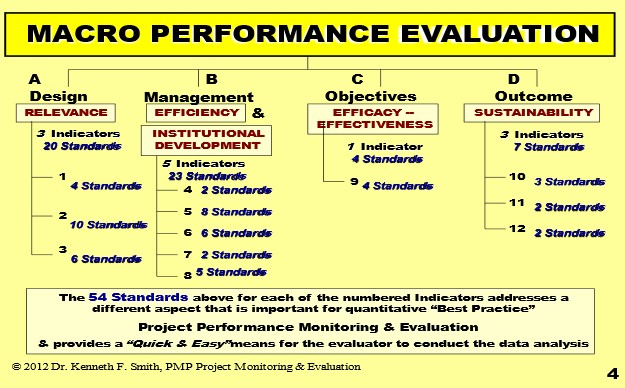A Trenchant Tool for Today’s
Project Management Practitioners
ADVISORY
By Dr. Kenneth Smith, PMP
Honolulu, Hawaii
& Manila, The Philippines
In its latest Guide to the Project Management Body of Knowledge (PMBOK) – i.e. the 7th – PMI® ‘deep-sixed’ the five-step project management process[1] of the past five decades, highlighted in previous editions. Instead, PMI focused on the hitherto missing sixth step – Evaluation of the Project Outcome — although IMO miscasting responsibility for this process on the project management implementation team, instead of the project sponsor(s).
Nevertheless, as I pointed out the PMWJ last year[2] — and even earlier[3] several years ago — it behooves project management teams to be familiar with their project’s objectives and the evaluation process, even if not responsible for them, or competent applying the related tools and techniques. To further that end, I have resurrected a relatively easy tool — Rapid Review & Quality Appraisal (RRQA) — for PMWJ readers, which was originally developed by the Australian Agency for International Development (AUSAID) at the beginning of the 21st Century for use by international donors assisting national & local government organizations, and NGOs,[4] to assess project status — usually about mid-term — towards attaining stated objectives. [5]
In 2004 I automated AUSAID’s RRQA for the Asian Development Bank’s (ADB) Independent Evaluation Department – where we dubbed it “REESI.”
Rapid Review & Quality Appraisal (RRQA) REESI[6] is a checklist of 54 qualitative ‘standards’ with 12 indicators deemed desirable criteria for a project’s success, in terms of 4 attributes — its Design, Management, Objectives and Outcome –in 5 dimensions shown in Figure 1, and further elaborated below:
Figure 1

- Relevance: Consistency of project impacts, outcomes and outputs with development strategy, Donor strategy & strategic objectives [Assess at approval, midterm and again when the project is completed]
- Effectiveness [Efficacy]: Achievement of Outcome & Impacts, physical, financial and institutional objectives as specified in the Policy and adopted at project approval, or as formally modified during implementation.
- Efficiency: Compares cost-effectiveness (FIRR &/or EIRR) of implementation to attain project
- Sustainability: Likelihood that human institutional & financial resources can support results and benefits over the project’s economic life after implementation.
- Institutional Development (& other impacts): Extent to which the project contributes improvements in the “enabling environment” so that its human, financial and natural resources can be more effective.
The Indicators and Standards – embedded in the template – are as shown in the following figures:
More…
To read entire article, click here
How to cite this article: Smith, K. F. (2023). Project Outcomes & The Project Evaluation Process: A Trenchant Tool for Today’s Project Management Practitioners, advisory article, PM World Journal, Vol. XII, Issue II, February. Available online at https://pmworldlibrary.net/wp-content/uploads/2023/02/pmwj126-Feb2023-Smith-project-outcomes-and-project-evaluation-process.pdf
About the Author

Dr. Kenneth Smith
Honolulu, Hawaii
& Manila, The Philippines
![]()
![]()
Initially a US Civil Service Management Intern, then a management analyst & systems specialist with the US Defense Department, Ken subsequently had a career as a senior foreign service officer — management & evaluation specialist, project manager, and in-house facilitator/trainer — with the US Agency for International Development (USAID). Ken assisted host country governments in many countries to plan, monitor and evaluate projects in various technical sectors; working ‘hands-on’ with their officers as well as other USAID personnel, contractors and NGOs. Intermittently, he was also a team leader &/or team member to conduct project, program & and country-level portfolio analyses and evaluations.
Concurrently, Ken had an active dual career as Air Force ready-reservist in Asia (Japan, Korea, Vietnam, Thailand, Indonesia, Philippines) as well as the Washington D.C. area; was Chairman of a Congressional Services Academy Advisory Board (SAAB); and had additional duties as an Air Force Academy Liaison Officer. He retired as a ‘bird’ colonel.
After retirement from USAID, Ken was a project management consultant for ADB, the World Bank, UNDP and USAID.
He earned his DPA (Doctor of Public Administration) from the George Mason University (GMU) in Virginia, his MS from Massachusetts Institute of Technology (MIT Systems Analysis Fellow, Center for Advanced Engineering Study), and BA & MA degrees in Government & International Relations from the University of Connecticut (UCONN). A long-time member of the Project Management Institute (PMI) and IPMA-USA, Ken is a Certified Project Management Professional (PMP®) and a member of the PMI®-Honolulu and Philippines Chapters.
Ken’s book — Project Management PRAXIS (available from Amazon) — includes many innovative project management tools & techniques; and describes a “Toolkit” of related templates available directly from him at kenfsmith@aol.com on proof of purchase of PRAXIS.
To view other works by Ken Smith, visit his author showcase in the PM World Library at https://pmworldlibrary.net/authors/dr-kenneth-smith/
[1] PMI’s Five Project Process Groups: Initiation, Planning, Execution, Monitoring & Control, and Closeout
[2] On the Subject of the PMBOK Guide, 7th Edition, Letter to the Editor, PM World Journal, Vol. XI, Issue II, February 2022. https://pmworldlibrary.net/wp-content/uploads/2022/02/pmwj114-Feb2022-Smith-on-the-pmbok-guide-7th-ed-Letter-to-Editor.pdf
[3] Evaluation: The Project Management Cycle’s Sixth Dimension; PM World Journal, Vol. VII, Issue X – October 2018. https://pmworldlibrary.net/wp-content/uploads/2020/10/pmwj75-Oct2018-Smith-Evaluation-the-project-management-cycle-sixth-dimension-commentary.pdf
[4] NGO: Non-Government Organization – a non-profit socially-active-oriented &/or charitable organization for community social betterment, political interaction in various aspects of economic development.
[5] NOTE: As discussed in the ‘Sixth Dimension’ article, it is not a good practice to be in charge of the evaluation of a project you are responsible for implementing, as your objectivity with respect to the findings will always be open to question. Better to assist External evaluators. Nevertheless, a RRQA is a useful ‘Do It Yourself’ (DIY) checkup.
[6] REESI: Relevance, Efficiency, Effectiveness, Sustainability & Institutional capability. [We also sent back a congratulatory acknowledgement of RRQA to AUSAID, and a courtesy copy of the template for their use.]









